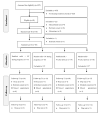Vitamin D and Calcium Milk Fortification in Pregnant Women with Periodontitis: A Feasibility Trial
- PMID: 33143369
- PMCID: PMC7662458
- DOI: 10.3390/ijerph17218023
Vitamin D and Calcium Milk Fortification in Pregnant Women with Periodontitis: A Feasibility Trial
Abstract
This study aims to assess the acceptability, adherence, and retention of a feasibility trial on milk fortification with calcium and vitamin D (Ca+VitD) and periodontal therapy (PT) among low income Brazilian pregnant women with periodontitis (IMPROVE trial). This 2 × 2 factorial feasibility trial used a mixed-methods evaluation. In total, 69 pregnant women were randomly allocated to four groups: 1. fortified sachet with Ca+VitD and milk plus early PT (throughout gestation); 2. placebo and milk plus early PT; 3. fortified sachet with Ca+VitD and milk plus late PT after childbirth; 4. placebo and milk plus late PT. Data were collected via questionnaires, field notes, participant flow logs, treatment diary, and focal group discussions. Quantitative and qualitative data were analysed using appropriate descriptive statistics and content analysis, respectively. Eligibility rate (12%) was below the target of 15%, but participation (76.1%) and recruitment rate (2 women/week) exceeded the targets. Retention rate (78.6%) was slightly below the target (80%). Adherence to the PT was significantly higher in the early treatment groups (98.8%) compared to the late treatment groups (29%). All women accepted the random allocation, and baseline groups were balanced. There was no report of adverse events. This multi-component intervention is acceptable, well-tolerated, and feasible among low-risk pregnant women in Brazil.
Keywords: acceptability; adherence; attrition rate; feasibility; milk fortification; periodontal therapy; pregnancy.
Conflict of interest statement
The authors declare no conflict of interest
Figures


Similar articles
-
Exploratory Efficacy of Calcium-Vitamin D Milk Fortification and Periodontal Therapy on Maternal Oral Health and Metabolic and Inflammatory Profile.Nutrients. 2021 Feb 27;13(3):783. doi: 10.3390/nu13030783. Nutrients. 2021. PMID: 33673568 Free PMC article. Clinical Trial.
-
Calcium and vitamin D supplementation and/or periodontal therapy in the treatment of periodontitis among Brazilian pregnant women: protocol of a feasibility randomised controlled trial (the IMPROVE trial).Pilot Feasibility Stud. 2019 Mar 5;5:38. doi: 10.1186/s40814-019-0417-6. eCollection 2019. Pilot Feasibility Stud. 2019. PMID: 30873290 Free PMC article.
-
Recruitment of low-income pregnant women into a dietary and dental care intervention: lessons from a feasibility trial.Trials. 2020 Mar 5;21(1):244. doi: 10.1186/s13063-020-4142-5. Trials. 2020. PMID: 32138765 Free PMC article. Clinical Trial.
-
Vitamin Fortification of Fluid Milk.J Food Sci. 2017 Apr;82(4):856-864. doi: 10.1111/1750-3841.13648. Epub 2017 Mar 2. J Food Sci. 2017. PMID: 28253423 Review.
-
Vitamin D Fortification of Fluid Milk Products and Their Contribution to Vitamin D Intake and Vitamin D Status in Observational Studies-A Review.Nutrients. 2018 Aug 9;10(8):1054. doi: 10.3390/nu10081054. Nutrients. 2018. PMID: 30096919 Free PMC article. Review.
Cited by
-
Exploratory Efficacy of Calcium-Vitamin D Milk Fortification and Periodontal Therapy on Maternal Oral Health and Metabolic and Inflammatory Profile.Nutrients. 2021 Feb 27;13(3):783. doi: 10.3390/nu13030783. Nutrients. 2021. PMID: 33673568 Free PMC article. Clinical Trial.
-
Calcium supplementation (other than for preventing or treating hypertension) for improving pregnancy and infant outcomes.Cochrane Database Syst Rev. 2024 Nov 19;11(11):CD007079. doi: 10.1002/14651858.CD007079.pub4. Cochrane Database Syst Rev. 2024. PMID: 39560075
-
Vitamin D supplementation for women during pregnancy.Cochrane Database Syst Rev. 2024 Jul 30;7(7):CD008873. doi: 10.1002/14651858.CD008873.pub5. Cochrane Database Syst Rev. 2024. PMID: 39077939 Free PMC article.
-
Association between Pre-Pregnancy BMI and Inflammatory Profile Trajectories during Pregnancy and Postpartum in Brazilian Women with Periodontitis: The IMPROVE Trial.Int J Environ Res Public Health. 2022 Feb 25;19(5):2705. doi: 10.3390/ijerph19052705. Int J Environ Res Public Health. 2022. PMID: 35270396 Free PMC article. Clinical Trial.
-
Calcium and Vitamin D Supplementation as Non-Surgical Treatment for Periodontal Disease with a Focus on Female Patients: Literature Review.Dent J (Basel). 2022 Jul 1;10(7):120. doi: 10.3390/dj10070120. Dent J (Basel). 2022. PMID: 35877394 Free PMC article. Review.
References
Publication types
MeSH terms
Substances
LinkOut - more resources
Full Text Sources
Medical

